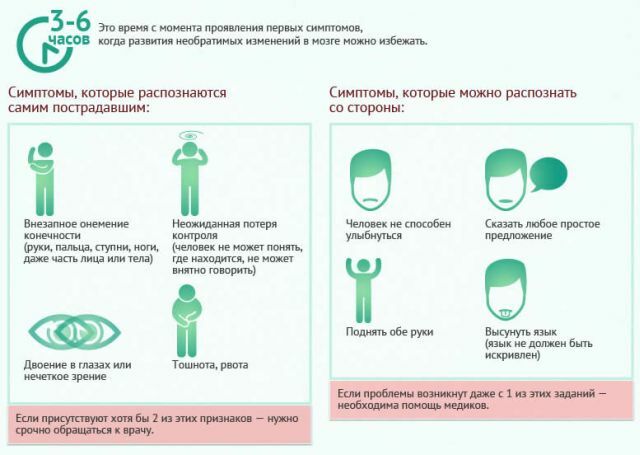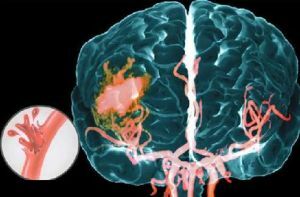 Stroke is considered one of the most serious neurological disorders, because it can lead to disability or death.
Stroke is considered one of the most serious neurological disorders, because it can lead to disability or death.
A particularly dangerous form of this disease is hemorrhagic stroke, which is characterized by the outflow of blood to the brain.
Contents
- Features of the
- Disease specificities
- Factors that can cause a stroke
- Symptoms
- Objectives and therapies
- Complications and consequences
- If the right hemisphere is affected
- Left hemisphere assault
- Prevention
Features of the disease
This disease occurs as a result of rupture of the blood vessel and hemorrhage in thebrain. This organ has a high sensitivity to various bleeding, and therefore damage can happen very quickly.
It irritates brain tissue, provoking the development of edema. Blood accumulates in the tissues of the body and has a pronounced toxic effect.
As a result, brain cells weaken and die. In addition, bleeding increases the pressure on the brain, pressing it against the skull.
Factors that can cause a stroke
There are many causes of hemorrhagic stroke of the brain:
- Arterial hypertension.
- Vascular aneurysms.
- Arterio-venous malformations.
- Inflammations and dystrophic lesions of the vascular walls - these include vasculitis and amyloid angiopathy.
- Pathologies, which are accompanied by a violation of blood clotting, - hemophilia, thrombocytopenia.
- Use of antiplatelet agents, anticoagulants, fibrinolytic drugs - heparin, warfarin, aspirin.
- Cirrhosis of the liver, which is characterized by problems with blood coagulability in the liver and a decrease in the number of platelets. This all inevitably leads to bleeding and hemorrhage, which can occur in the brain.
- Hemorrhages in the brain tumor.
In addition to the causes that lead to a violation of the integrity of the walls of the vessels, there are also predisposing factors:
- smoking;
- excessive consumption of alcoholic beverages;
- addiction;
- set of excess weight;
- lipid spectrum disorder;
- age changes - at risk people over 50;
- diabetes;
- hereditary predisposition.
If we talk about hemorrhagic stroke, we can not fail to note the danger of atherosclerotic lesions of the walls of 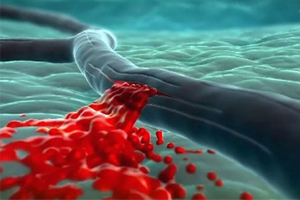 vessels.
vessels.
Usually, the appearance of lipid plaques provokes closure of the lumen, which is accompanied by the development of necrosis. In addition, damage to the vascular wall in combination with increased pressure can lead to tissue rupture, which will lead to hemorrhage.
Symptoms
Clinical signs of the disease are directly related to the lesion and its size. Depending on the damage to various brain structures, various symptoms may occur.
In most cases, there are problems in the motor and sensitive areas. When the cerebral hemispheres are affected, speech is disturbed.
Depending on the moment of appearance of the pathology and its symptoms, such periods of a stroke are distinguished:
- acute period;
- recovery period;
- residual phenomena.
For an acute period characterized by cerebral manifestations, which are associated with increased pressure in the skull. It can last for a week and is accompanied by a gradual accumulation of blood.
As a result, the risk of damage to nervous tissue and the development of necrosis is increased. The most dangerous condition in this period is the development of cerebral edema , which significantly increases the likelihood of death.
The recovery period usually starts from 2-4 weeks. At this time, the brain is undergoing reparative processes, which are aimed at cleansing the blood and restoring the structure of the parenchyma.
Stroke often provokes a subarachnoid hemorrhage. What other factors can cause hemorrhage in the brain?
It is very important to choose the right food after a stroke. Basic rules, as well as an exemplary menu and other useful information about the power system.
This period usually lasts for several months.
Residual effects persist for life. If timely treatment and subsequent recovery, then the hemorrhagic stroke completely recedes - it is possible to restore the motor activity, speech, return the person to work capacity.
The attack usually begins in the daytime with increased blood pressure. It can be the result of increased physical exertion or nerve strain. Man sharply loses consciousness and falls.
Autonomic symptoms may appear-changes in body temperature, sweating, redness, or pallor of the skin.
Some people develop breathing disorders, tachycardia or bradycardia develop. Sometimes a patient quickly falls into a coma.
All manifestations of the disease are divided into two categories.
So, cerebral symptoms are associated with increased pressure and include the following:
- severe headache;
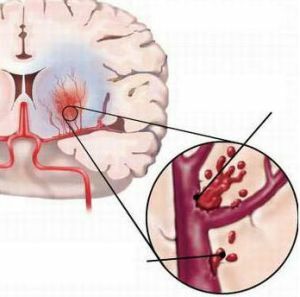
- impaired consciousness;
- vomiting;
- convulsions.
Focal neurological signs are associated with impaired work of a particular department of the nervous system. Most often hemispheric hemorrhages develop, which are characterized by such symptoms:
- Hemiplegia or hemiparesis - complete or partial loss of motor activity of the arm and leg, develops on the side opposite to the lesion focus.
- Decreased muscle tone and tendon reflexes.
- Hemi hypoesthesia - is a violation of sensitivity.
- Vision paresis - in this case, the eyeballs are directed towards the lesion.
- Middrias - this symptom is the dilatation of the pupil on the side of the hemorrhage.
- Omission of the corner of the mouth.
- Smoothness of the nasolabial triangle.
- Speech disorders in the defeat of the dominant hemisphere.
- Development of pathological reflexes.
When the cerebellum is disturbed, the distinctive features of the stroke will be pain in the nape of the neck, severe dizziness, vomiting, speech and gait disturbance, and inability to stand.
Subarachnoid hemorrhage is characterized by severe headache and other general cerebral manifestations.
Breaking the brainstem is considered the most dangerous condition, because it is here that the vital centers of the nervous system are located.
In this case, bilateral paralysis develops, the sensitivity of swallowing is impaired. A person can suddenly lose consciousness right up to the development of a coma.
The purposes and methods of therapy
All medical actions are directed on the decision of following problems:
- restoration of a circulation in a brain;
- elimination of cerebral edema;
- normalization of rheological characteristics of blood;
- stimulation of restorative processes in disturbed tissues.
- stimulation of neurogenesis;
- maintaining the work of organs and systems.
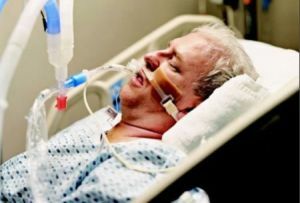 It is very important to normalize the level of blood pressure. It is often necessary to restore coronary circulation.
It is very important to normalize the level of blood pressure. It is often necessary to restore coronary circulation.
If necessary, the patient can be transferred to artificial respiration. With pulmonary edema, diuretics and cardiac glycosides are used.
In severe cases, a surgical procedure is indicated.
Complications and consequences of
After the appearance of hemorrhagic stroke, such complications can develop:
- Disruption of motor activity and coordination of movements .
- Swallowing - this condition can trigger food ingestion into the respiratory tract.
- Problems with the perception of - with normal vision it is difficult for a person to understand what he sees.
- Behavioral disorders - after a stroke people often develop aggression and fearfulness, there is a slowdown in reactions.
- Speech disorder - after a hemorrhagic stroke, difficulties with understanding and reproduction of speech may appear.
- Cognitive impairment of - is the appearance of problems with the perception of information, memory impairment.
- Dysfunction of the intestine and bladder - after a stroke, urinary and fecal incontinence is often observed.
- Epilepsy - develops in approximately 7-20% of cases.
- Psychological disorders - patients often experience sharp changes in mood, anxiety, irritability.
- Pain syndrome - sometimes a stroke leads to the appearance of pains of a different nature, which are not eliminated by pain medication.
If the right hemisphere is affected
If a hemorrhagic stroke affects the right side of the brain, then a person develops hemiparesis on the left. Most often, it is accompanied by impaired muscle tone and loss of sensitivity.
Hitting the left hemisphere
If the stroke is affected the left side of the brain is characterized by partial or complete paralysis of the trunk on the right side.
Sensitivity and muscle tone disorders may also occur. A distinctive feature of such a stroke is the rapid development of speech disorders and motor aphasia.
Prevention of
To minimize the threat of developing a hemorrhagic stroke, should give up smoking .
In addition, it is very important to eat properly - in the diet must be present fruits and vegetables, foods with a high content of potassium.
You should also limit salt intake and monitor your weight.
To reduce the risk of developing atherosclerosis and stroke, special exercises should be performed.
Hemorrhagic stroke is a very dangerous disorder that can lead to serious health consequences.
To reduce the risk of this disease, it is worthwhile to work on its prevention. If symptoms of the disease appear, you should immediately call an ambulance.


